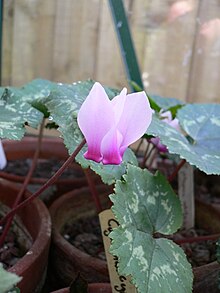Cyclamen rohlfsianum: Difference between revisions
m →Books: http→https for Google Books and Google News using AWB |
Rescuing 1 sources and tagging 0 as dead. #IABot (v1.5beta) |
||
| Line 46: | Line 46: | ||
{{commons category}} |
{{commons category}} |
||
{{wikispecies}} |
{{wikispecies}} |
||
*[http://www.cyclamen.org/rohlf_set.html Cyclamen Society] |
*[https://web.archive.org/web/20100325122503/http://www.cyclamen.org/rohlf_set.html Cyclamen Society] |
||
*[http://www.bulbsociety.org/GALLERY_OF_THE_WORLDS_BULBS/GRAPHICS/Cyclamen/Cyclamen_rohlfsianum/C_rohlfsianum.html Gallery of the World's Bulbs] — International Bulb Society |
*[http://www.bulbsociety.org/GALLERY_OF_THE_WORLDS_BULBS/GRAPHICS/Cyclamen/Cyclamen_rohlfsianum/C_rohlfsianum.html Gallery of the World's Bulbs] — International Bulb Society |
||
*[http://www.ars-grin.gov/cgi-bin/npgs/html/taxon.pl?12748 Germplasm Resources Information Network] |
*[http://www.ars-grin.gov/cgi-bin/npgs/html/taxon.pl?12748 Germplasm Resources Information Network] |
||
Revision as of 22:58, 15 August 2017
| Cyclamen rohlfsianum | |
|---|---|

| |
| Scientific classification | |
| Kingdom: | |
| (unranked): | |
| (unranked): | |
| (unranked): | |
| Order: | |
| Family: | |
| Genus: | |
| Subgenus: | |
| Series: | |
| Binomial name | |
| Cyclamen rohlfsianum | |
Cyclamen rohlfsianum is a perennial growing from a tuber, native to shrubland, especially in limestone cracks, up to 450 m (1,500 ft) above sea level in a small area of northeastern Libya. It is one of the tenderest cyclamen species.
The plant was discovered by Friedrich Gerhard Rohlfs in 1879, and was named after him in 1897 by Paul Friedrich August Ascherson.
Description
Tubers are round when young, but become irregular with age, with multiple growing points across the surface of the tuber.[1] Cyclamen purpurascens also has irregular older tubers.
Leaves are large, with pointed lobes and prominent ribs, and wider than long. Leaves of Cyclamen hederifolium often have lobes, but are usually longer than wide.
Flowers bloom in autumn with the young leaves and have 5 upswept petals, light pink with a darker nose. The stamens and pistil project below the nose, suggesting the shooting stars (Dodecatheon), but unlike any other cyclamen.
Cultivation
Cyclamen rohlfsianum has a longer summer dormancy than many other cyclamen species and flowers best after a hot, sunny summer. In this way it is similar to Cyclamen graecum and Cyclamen africanum.
Gallery
-
young leaf
-
varied leaf patterns at Tile Barn Nursery
References
Notes
- ^ reply #435. Cyclamen 2009. Scottish Rock Garden Club Forum.
Books
- C. Grey-Wilson. Cyclamen: a guide for gardeners, horticulturists, and botanists. p. 141. Google Books.
External links
- Cyclamen Society
- Gallery of the World's Bulbs — International Bulb Society
- Germplasm Resources Information Network


